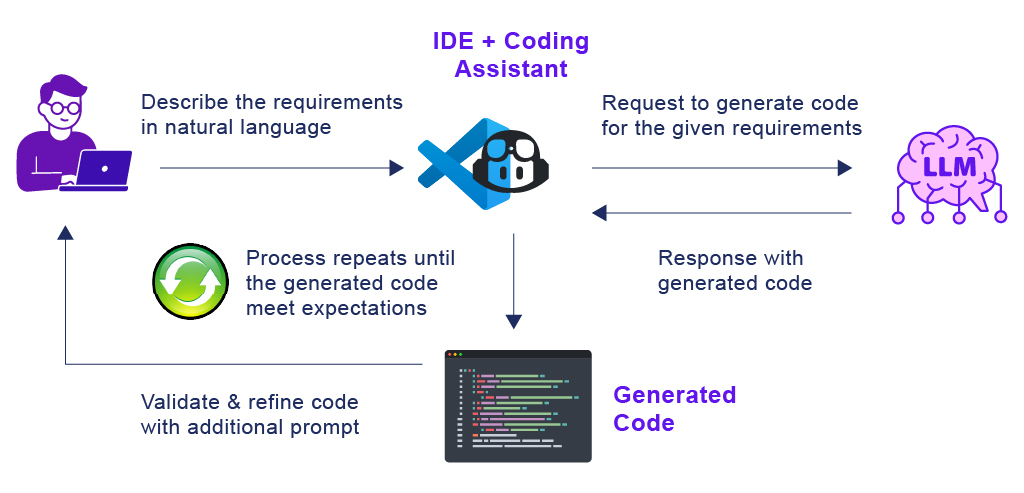The Vibe Coding Promise: Why Your Dev Team Isn’t 50% Faster Yet
Vibe coding sounds perfect: faster development, lower costs, democratized coding. Here’s what enterprise teams are actually experiencing—and what works instead.
The pitch sounds irresistible: Cut development costs by 40%, ship features twice as fast, and let your product managers write production code. But if “vibe coding” was the silver bullet for software development, why isn’t every enterprise already reaping these benefits?
What is Vibe Coding?
Vibe coding transforms natural language requirements into working code through AI assistants like GitHub Copilot, Cursor, and other AI-powered IDEs integrated directly into development environments. Developers describe what they need in plain English, the AI generates code, and, through iterative refinement, the solution evolves until it meets requirements.

The promise is compelling: faster development cycles, reduced headcount needs, and the democratization of coding across non-technical teams.
For cost-conscious executives, it appears to offer a path to significant operational savings while accelerating time to market.
But here’s the reality:
The Enterprise Reality Check
Technical Limitations
Vibe coding excels at prototypes and proof-of-concepts, but it faces challenges with the complex, interconnected systems that power modern enterprises. When your application needs to integrate with legacy systems, handle millions of concurrent users, or meet strict compliance requirements, AI-generated code often requires substantial refinement.
Code Quality and Performance Considerations
While AI can produce functional code quickly, it rarely produces optimized code. The generated solutions typically require refactoring to meet production standards. For distributed systems requiring sophisticated architecture and performance tuning, initial development speed can be offset by optimization cycles.
Debugging Challenges
AI-generated code can present troubleshooting difficulties. Without consistent architectural patterns or naming conventions, senior developers may spend considerable time understanding the AI’s logic. This creates technical debt that accumulates over time.
Maintenance Overhead
Enterprise applications have lifespans measured in years, not months. AI-generated codebases experience 300% higher churn rates, with every change introducing 400% more bugs. Our analysis shows that this trend is accelerating compared to traditionally developed code.
“AI-generated codebases experience 300% higher churn rates, with every change introducing 400% more bugs.”
Security Considerations
AI-generated code can bypass standard security review processes. The speed of generation may lead teams to reduce thorough audits, creating potential vulnerabilities.
Strategic Applications for Vibe Coding
While vibe coding can’t yet replace your engineering team, it does have valuable applications:
- Rapid Prototyping: For validating concepts before committing significant development resources, vibe coding can compress weeks of work into days.
- Internal Tooling: Simple automation scripts and internal utilities represent ideal use cases where rapid iteration is valued over perfection.
- Developer Productivity: When used as an intelligent code completion tool rather than a complete solution generator, AI can genuinely accelerate experienced developers.
The Enterprise Alternative: Spec-Driven Development
For enterprise-grade applications, success requires moving beyond trial-and-error iteration toward a more disciplined approach: Spec-Driven Development.
Unlike vibe coding’s iterative “generate-test-refine” cycle, spec-driven development starts with comprehensive requirements specification before any code generation. AI operates within predefined architectural constraints and security standards, producing code that aligns with enterprise requirements from the first iteration.
This methodology combines the speed of AI with the rigor your business-critical applications demand.
The Bottom Line
Vibe coding represents a significant technological advancement, but it’s not yet the complete solution the hype suggests. For enterprise leaders, the key is implementing AI thoughtfully — as a powerful tool within a disciplined development process rather than a replacement for engineering expertise.
The organizations that will benefit most are those that resist the hype, understand the limitations, and integrate AI capabilities strategically within proven development methodologies.
What Relevantz Can Do for You
Ready to explore how Spec-Driven Development can accelerate your development cycles without compromising quality? Contact us to schedule a complimentary consulting session.
